Classical Music & French Composers
Ladies of fashion during 19th & 20th century heard classical music from
French Composers in our Archive.
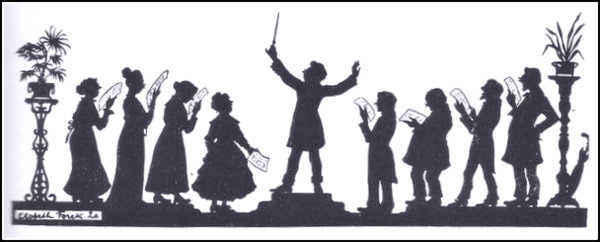
Music appreciation
To give a historical perspective into this prolific age in Paris, we have included some famous and rare musical references. The earliest dates begin our great Composer’s archive. The Composer’s Photographs/Paintings have been especially collated for this Musical reference.. ~ “Good music resembles something. It resembles the Composer”. By Jean Cocteau
Jean Baptiste Lully 1632-1637
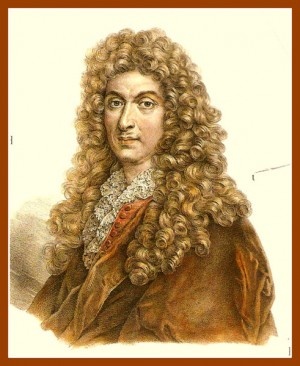
Jean Baptiste Lully
Jean Baptiste Lully was born Giovanni Batista Lulli in Florence, Italy. He arrived in France during March 1646 as a tutor for the niece of Roger de Lorraine, the Chevalier de Guise, who had asked for someone with whom she could practice her Italian language skills. During the six years at this household he polished his skills as a composer and performer. He was already an expert on the guitar and violin.
His first job was to write music for the court ballets. He had a quick temper and was a homosexual which he covered by marrying the daughter of the court composer Michael Lambert.
Lully collaborated with playwrite Moliere producing several comedies-ballets (half play,half ballet). The most famous being Le Bourgeois Gentilhomme (1670). In 1672 he began to import Italian opera through a licence he had obtained from a bankcrupt fellow musician. He established a virtual monopoly on productions performed at the newly opened Palace of Versailles. He opened his own Opera House in Paris. He then turned out his old friend Moliere’s troupe of actors who were useing the centrally sited Palais Royal, taking it over with the King’s permission, rent-free.
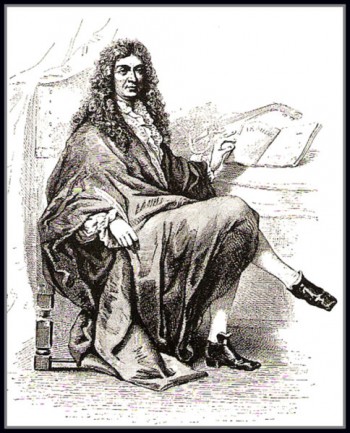
- Jean Baptiste Lully
Over the next fourteen years Lully and the poet Phillipe Quinault produced a succession of brilliant operas in a new and original style. These’lyric tragedies’ were based on subjects from mythology and legend. He flattered King Louis XIV and the audiences loved the productions. He struck gold making a vast fortune.
While conducting a performance of a Te Deum he accidently struck his foot with a heavy stick which he used to mark the beat on the floor. Gangrene set in but he refused to have his toe amputated. As he lay dieing as priest visited him and as a final penitence he threw his last opera’s manuscript on the fire. After the priest had gone a horrified friend asked him why he had destroyed the manuscript, Lully replied ‘don’t worry I’ve got another copy!’
The most played recordings for Jean Baptiste Lully are: The recordings available now.

Francois Couperin 1668-1733
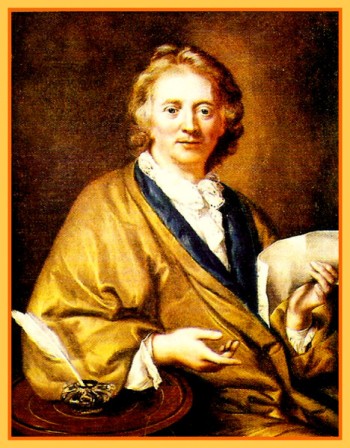 Francois Couperin A member of a large family he was called Le Grand to distinguish him from the other syblings. He was taught by his father and the organist at the royal chapel, Jacques-Denis Thomelin whom he suceeded in 1693. Couperin was a brilliant harpischordist,and soon became court music teacher.
Francois Couperin A member of a large family he was called Le Grand to distinguish him from the other syblings. He was taught by his father and the organist at the royal chapel, Jacques-Denis Thomelin whom he suceeded in 1693. Couperin was a brilliant harpischordist,and soon became court music teacher.
In 1716 he published a text book (the Art of playing the Harpsichord) which had a great influence on the development of J.S. Bach. He was also influenced by the great Italian composer Corelli.Couperin’s music had charm and wit, whereas Corelli had warmth and sincerity. Couperin wanted to express in his music a person’s appearance,character, nature and behaviour.From.
1722 he published a number of ‘concerts royaux’ for chamber orchestra. These were played nearly every Sunday for Louis XIV. These were much appreciated and admired for there profound musical intuition.
Recommended Recordings, Les Concerts Royaux,Cond Jordi Savall. Label Alia Vox Spain, No BOOO7Y8A9W. Complete works for harpsichord.Oliver Baumont, Box Set Booo0CZ7WK.

Jean Phillippe Rameau 1683-1764
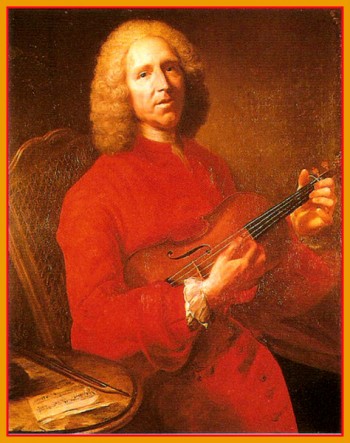 The original intention was for him to become a lawyer but his father realised he was showing a great musical talent and encouraged him to learn the harpsichord,organ and violin.It was through his own insights that he developed his great theoretical knowledge and practice of the science of harmony. He went to Italy and became acquainted with the Italian music of the time. He returned to France becoming organist at Clermont cathedral in the Auvergne and then returned to Paris in 1706.The result of further studies into acoustics and harmony resulted in his ‘Treatise on Harmony’ published in 1726 which became the foundation of modern musical theory. He remains one of the greatest musical theorists of all times.
The original intention was for him to become a lawyer but his father realised he was showing a great musical talent and encouraged him to learn the harpsichord,organ and violin.It was through his own insights that he developed his great theoretical knowledge and practice of the science of harmony. He went to Italy and became acquainted with the Italian music of the time. He returned to France becoming organist at Clermont cathedral in the Auvergne and then returned to Paris in 1706.The result of further studies into acoustics and harmony resulted in his ‘Treatise on Harmony’ published in 1726 which became the foundation of modern musical theory. He remains one of the greatest musical theorists of all times.
His reputation as a musician brought him many pupils a contract with the court and compositions for the theatre. His masterpiece , Castor et Pollux, was produced in 1737. He is considered to be the father of programme music.Compared to Lully he was a radical inventor, useing many daring harmonies and modulations with many imaginative and novel orchestrations. Karl Nef a Swiss musicoligist, wrote the following’ His characteristic ability and unfailing imagination show him to be the complete master of the 18th century. Holding fast to form,he composed minuets,gavottes,rigaudons,bourrees and marches stamped by an extraordinary formulistic delicacy, but strengthened by rich and daring harmonies.In this sphere, Rameau was the most original inventor of all time’. It is said that on his deathbed he reproved the priest for intoning his prayers out of tune.
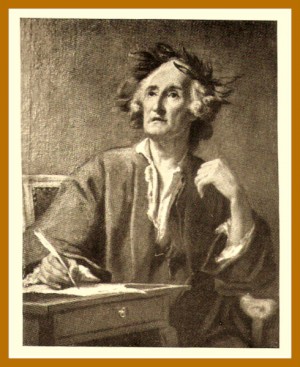
- Jean Philip Rameau
Recommended Recordings: Hippolyte et Aricie.Condt Marc Minowski Les Musiciens de Louvre.Archive Production BOOOO57EU
Les Indes Galantes Christophe Rousset Harpsicord.
Hector Berlioz 1803-1869
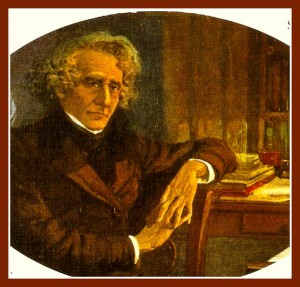
Hector Berlioz
Hector Berlioz had a facility to compose from a very early age. He learnt the flute and managed to play and entertain his family after only a few days. He received occasional piano and guitar lessons from the conductor of the local town orchestra. He, however, learnt most of his early musical knowledge from reading in bed at night!
At the age of nineteen he was sent to Paris to study medicine. His first lesson on dissection so appalled him that he escaped through a window determined never to become a doctor. He was completely bewitched by Gluck’s opera ‘Iphigenia in Tauris’. He studied the score, wrote it down and then learnt by heart. He stated he could not sleep or eat. It completely blew him away.
He entered the conservatoire as a pupil of Lesureur. He had an early Mass performed,after which his teacher said ‘You will neither be a doctor nor a chemist, but a great composer because you are a genius, it is true! He entered the Prix de Rome but was not succesful. His father asked him to return home but relented when he discovered his son wanted to become a composer. He entered the Paris Conservatoire for the second time in 1826. He ran into debt after which his father cut off his allowance. To make ends meet he gave guitar and flute lessons and joined the chorus of a third rate revue to subsidise his income.
He fell madly in love with the Irish actress Harriet Smithson . However his love was not reciprocated and she completely ignored him. He then had the idea of composing a work outlining his own colourful life. The Symphonie Fantastique was composed in 1830. It is one of the most original pieces of music ever composed. Beethoven had only been dead for three years and suddenly another great composer had immerged to take his place but this time from France. Franz Liszt was deeply impressed and immediately backed him.

Paganini by Leon Bakst
He wrote a marvellous work entitled ‘Harold in Italy’ for the famous violinist Paganini. Paganini had recently acquired a Stradivarius viola and asked Berlioz to compose a piece for him. When Berlioz showed him the work he rejected it on the grounds that it was not difficult enough and that the soloist was not playing continually during the performance. Paganini rejected it and the premiere was played by Chretien Urhan who was a well known soloist . However in 1838 Paganini heard the piece and was so impressed that he dragged Berlioz on to the stage and knelt before him in front of a cheering audience. He sent a cheque of 20,000,00 Francs to Berlioz in appreciation of this piece .
Berlioz had eventually won the Prix de Rome in 1830 and stayed there for three years . It was not a artisically successful time. He returned to Paris to find that Harriet was crippled by a broken ankle and that the company she worked for had gone bankcrupt. Berlioz married her and a a son Louis was born in 1834. The marriage was unhappy and they separated after seven years. He gradually became well known as a composer but the French did not really understand him.Lacking money as a composer he took up musical criticism and journalism, work he hated but he had a very varied literary style.
His great Requiem was written in 1837. It was written at such speed that he had to invent his own shorthand to write it down as his musical thoughts came so quickly that he needed to get them transcribed before they disappeared from his brain. He had great success abroad,especially in England and Germany. The French continued to under estimate him.
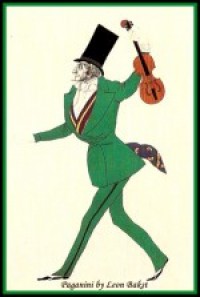
Paganini by Leon Bakst
In 1847 he signed a six year contract as an opera conductor in London, however the company failed after a year. He , however, began composing a Te Deum in 1848 finishing it in 1849.He had hardly finished it when he started to rework the score. After hearing a performance in St Paul’s Cathedral in June 1851 he added a children’s chorus (sopranos and altos).( We have in our possession an original letter dated 1851 in which Berlioz discusses the size of the chorus he might use. This incredible ‘find’ was picked up in the Dordogne , France at a car boot sale which the seller had left in an unmarked envelope.)
The first revised performance too place at St Saint-Eustache in Paris on April 30th April 1855. It was a complete triumph. There was a performance of excerpts on November 16th 1855 at the closing of the Universal Exibition using some twelve hundred and fifty musicians and singers. His first wife died in 1854 and he married the singer Marie Rico who had been his mistress for many years. Marie died in 1862 this combined with the deaths of several close friends and his son Louis left him very lonely in his old age. Henri Prunieres (famous musicologist known for amongst other things as the founder of ‘Le Revue Musicale, one of the most intellectual musical revues from which he founded in 1920 and continued until 1939), said ‘ Berlioz truly laid the foundation stone of the whole of the revolutionary movement in new forms which French musicians championed from 1870 to 1920. He broke down all the traditional forms and laws which were strangling music and opened the door to the future’.Romain Rolland (French dramatist,novelist,essayist, and art historian who won the Nobel Prize for literature in 1915) said that ‘Berlioz had more genius than is to be found in all the other French music of his century,’ He was one of the greatest orchestrators who ever lived,which can be detected on hearing only a few bars. He must be considered one of the greatest composers. Then in 1864 when he had stopped composing and lost much of his spirit he went to visit Estelle who he had adored as a twelve year old. His subsequent meetings and letters were a great comfort to him in his last years. He published a brilliant ‘Treatise on Orchestration’ which still remains one of the best textbooks on the orchestra.
Recommended Recordings. RCA Boxed Set Charles Munch Boston Symphony .BOOOITSWPU 10 CD’s.

Charles Gounod 1818-1893
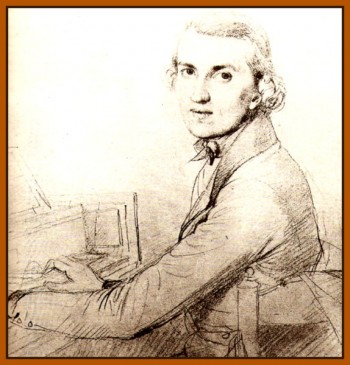
- The young Charles Gounod
Charles Gounod possessed a fresh sensibilty highly romantic style ,showing a mastery of musical dialogue without exaggeration. Charles Gounod,less talented than Berlioz was however to carry on excellent work. Faure,Duparc and Ravel respected his basic aims. His great opera Faust (1859) remains even today his most frequently played work. There is much emotional power in this work,the prelude and choral passages are particulary moving with the garden scene being a highpoint. His comic opera ‘Le Medecin Malgre lui’ is a great work filled with charm and humour. Two scores which should be better known are the 1st Symphony in E flat and the Little Symphony for Wind Instruments (1879). Perhaps his finest work,however,are his two hundred songs. The subtle modulations in harmony with clever use of dissonance allied with perfect balance of the piano often surpass the quality of Faure’s songs, often felt to be the greatest in 19th Century French music.
Gounod visited Mendelssohn in Leipzeg in 1843.He was received by the elder composer in a very courteous manner especially as Gounod was just twenty five at the time. He gave him full attention for the four days he spent with him. Gounod played him his latest works which were much appreciated by Mendelssohn who gave him every encouragment to continue. He came to know many German compostions which gave him a more profound feel to his own music. He composed an early opera Sapho in 1851,which was not a success.Gounod lived in England (1870-1875) one of his activities being the creation of the Albert Hall Choral Society. In later life he wrote several oratorias Le Redemption,Angeli Custodes,Christus Factus Est and Mors et Vita.He had a great gift for melody allied with much lyrical charm. His music can be tuneful,with elegant harmony and great humour. In France at that time several later composers were influenced by him, among the following being Massenet, Bizet and Cesar Franck. ( We have an original letter written by Gounod also found on the same day as the above Berlioz).
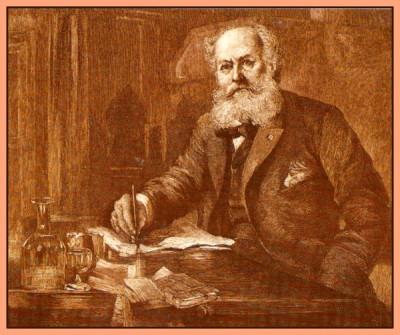
Recommended Recordings
Symphony NO 1 and NO 2 Naxos No BOOOH4VZ9O. St Cecilia Mass Cond Georges Pretre.EMI BOOOOO2RN5 Faust, Orchestra de Le Opera de Paris,Cond. Georges Pretre.EMI Classics BOOOOOROH, Romeo & Juliet, Orchestra du Capitole de Toulouse.cond Michel Plasson EMI Classics,BOOOOO63O8. Mireille, Orchestra de Opera de Paris.Cond Georges Pretre.Angel Records.BOOOOO5GIU.
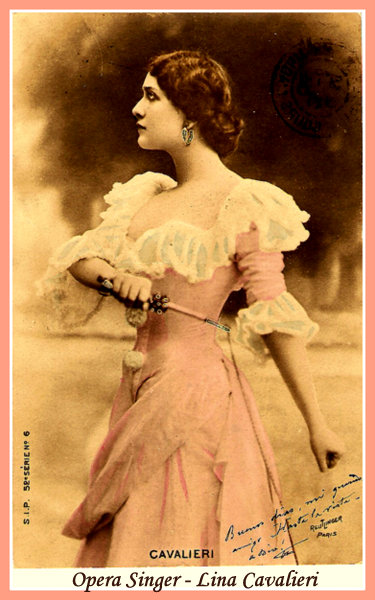
Opera Singer
Famous Opera Artist: Lina Cavalieri sang in Gounod’s most renowned Opera Faust. We have listed performances in date order as follows: Jan 29th 1901 (Warsaw Bolshoi Theatre), June 7th 1901 (St Petersberg),June 9th 1901,(St Petersberg), June 14th,1901 (St Petersberg), July 4th,1901 (St Petersberg), April 25th 1906, ( Moscow), May 8th 1906, (Kiev), February 13th, 1909,Philadelaphia Opera House.USA.
This was a Post Card found in an old village in the Dordogne, France.
Cesar Franck 1822-1890
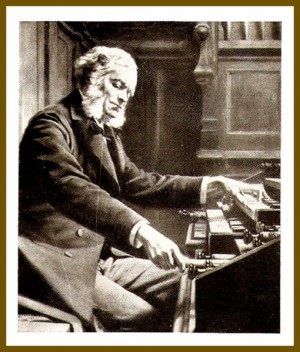
Cesar Franck
Cesar Franck was forced by his father to become a musician almost before he could walk. Cesar played the piano and his brother Joseph played the violin. He was sent to the best teacher of musical theory in Paris, Anton Reicha,and joined the Conservatoire in 1837. At a piano competition he found the piece so easy that he decided to transpose it a third lower. He played the piece in the new key with much success. The result was not what he expected.The director of the Conservatoire,Cherubini was very angry and refused to give him the first prize. However the performance was so remarkable that Cherubini gave him a grand prix d’honneur,an award never made before,or since, by the Conservatoire at such a competition. In 1851 he started working on his opera ,Le Valet de Ferme ,but it exhausted him so much that he had to give up composition for a time.
Five years later Franck finished his first large composition,the oratorio, Ruth.It was not well received and a further 20 years elapsed before there was a second performance. In February 1848 Franck was married in Notre-Dame-de-Lorrete, where he been appointed organist four years earlier. The marriage took place in the middle of the Revolution of 1848 and the bridal procession had to climb over the barricades on their way to the church. Franck had to give a few lessons in the morning to be able to pay for the wedding breakfast. The couple were happy ,Cesar having at last escaped from his father’s domineering authority. He did not long for riches and spent most of the day giving music lessons to earn a living while leaving two hours a day to continue his composing. By now Franck , a brilliant organist, was appointed organist in 1858 at the newly built church of St Clotilde which had one of the best organs in Paris. As an organist Franck was famous for his daring and imaginative improvisations. In 1872 he became professor of organ playing at the Paris Conservatoire. He had a very pleasant nature,naive and trusting much adored by his pupils who called him ‘Le pere Franck ‘. He,however,remained unknown as a composer because he could not afford to present his large scale works to the public. There were few beyond his pupils who knew and understood his music.
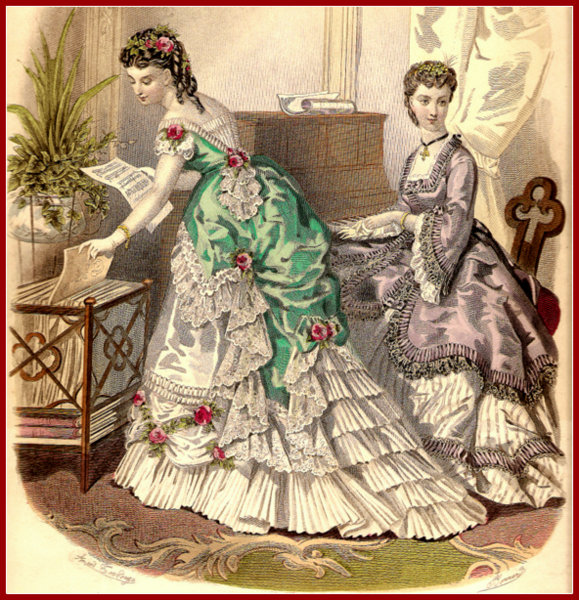
Finding her score - 1860
His first opus,The Beatitudes took 10 years to write. At the first private performance everything went wrong. The Minister of Culture,the Director of the Conservatoire and Opera were invited but declined to attend.Franck injured his hand so was unable to play the piano. Some of the critics attended but left before the performance ended.The whole performance was a failure.His friends told him that the work was too long for one evening.He was greatly disappointed but not embittered. It was not until 14 years later that the Beatitudes was performed again .It was a great success but Franck had been dead for three years. He struggled to gain popularity because he could not write opera which at this time was the only music that counted in Paris. He ,however, obtained his greatest expression in his only Symphony in D minor. He had much success with his String Quartet performed in Paris in 1890.Vincent d’Indy described the occaison: ‘The Hall shook with applause the like of which is seldom heard.People rose to their feet,called for the composer,clapped and screamed . Franck could not believe that the applause was for his music. Not until they persuaded him on to the platform ,where he stood smiling,confused and embarrassed,did he believe it.
A month later Franck was knocked down by a bus.His injuries led to a severe attack of pleurisy a few months afterwoods,and on 8th November 1890 he died. Frank’s most productive years where after the age of 50. He wrote his greatest works in the last years of his life. His melodiousness gave his compositions a peculiar almost naive grace. Most of Franck’s later works give evidence of his prolific inventiveness in their interersting treatment of motifs,contrapuntal skill, and combination of themes. His own compositions are the best examples of the principal of ‘a singing counterpoint’ which he drummed into all his pupils.
He had a deep love of the organ all his life.However his piano compositions, were written in two periods separated by nearly 40 years. His first compostions were virtuoso pieces now long forgotten,but in the second he created two of the most beautiful works for piano ever produced in France.He wrote them at the age of 62 because he thought that the repertoire of the French pianists needed renewing.These were his,Prelude,Chorale and Fugue and Prelude, Aria and finale.
Recommended recording : Symphony in D Minor with Stravinsky Petrouchka. Pierre Monteux. Boston Symphony and Chicago Symphony, RCA BOOO9U55RO
Edouard Lalo 1823-1892
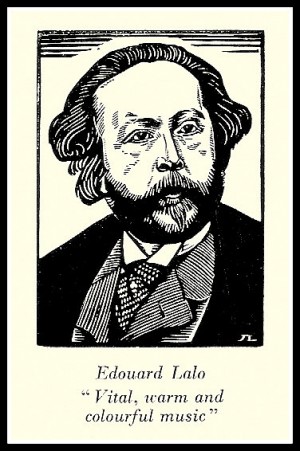
Eduard Lalo
Lalo at the beginning had great trouble in interesting people to his music.Partly the problem was that he wrote only chamber music which attracted a small audience. The rich and symphonic character of his music also detracted from gaining a large audience. When in 1865 he resumed composing after an absence of seven years Lalo ignored chamber music and concentrated on orchestral music. He still found it hard to excite the general public. However,in 1874 Sarasate played Lalo’s first violin concerto and then in 1875 his magnificent violin concerto named Symphonie Espagnole his greatness was realised. This work will probably live the longest of all his works.In later years he continued composing brilliant pieces such as Raposidie Norvegienne (1881) and Concerto Russe (1883).
Lalo achieved great success in opera when his ‘Le Roi d’ Ys was performed in 1888. He , however, had surmounted many difficulties to get it performed. Contrary to all expectations the work met with great success.Rene Dumesnil (musicologist, and critic) wrote ‘Lalo wrote for the stage he would have written for the concert hall,making no allowances for lack of taste’. Much has been said of his music for the ballet ‘Namouna’ (1882), now considered one of the gems of French music. Harmonically,the songs of Lalo complimented those of Gounod ,for, although they may not have the same charm,the richness of the instrumental accompaniment ,their rhythmic invention and understanding of the best French Romantic poets bring Lalo close to the spririt of the German Lied.
Recommended Recordings : Decca 425501,Joshua Bell Lalo Symphonie Espagnole,Saint Saens Violin Concerto No.3. Montreal Sym.Charles Dutoit Cond.
Bis 1296. Symphony in G minor,Cello Concerto,Namouna Ballet Music,Torleif Thedeen Cello,Malaysian Phil Orchestra,Kees Bakels,Conductor.
‘
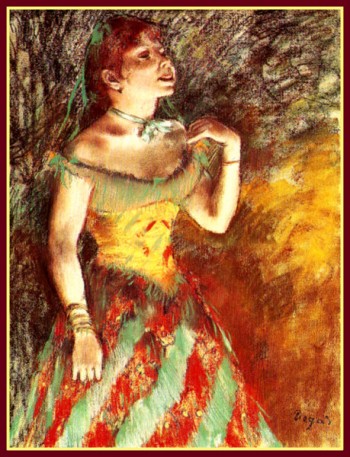
Edgar Degas pastel 1882/1885
Le Chanteuse Verte
There is delight in singing, though none hear – Beside the singer.
Walter Savage Landor
So just, so small, yet in so sweet a note, it seeme’d the music melted in the throat
John Dryden
Camille Saint-Saens 1835-1922
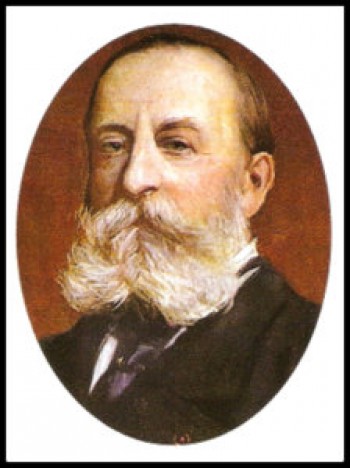
Saint-Saens showed very early on that he possessed great musical talents.He made his first public appearance at the age of 5 and when his was 10 he gave a piano recital at the Salle Pleyel which prompted the Paris newspapers to hail him as the new Mozart. Fortunately his parents did not wish him to be a child prodigy and he therefore received a normal school education until he was 14 when he entered the Paris Conservatoire.
Three years later he became an organist , and he had his !st Symphony performed when he was 18. He was know as one of the greatest organ players of the time and also made his mark as a pianist and a conductor. Gradually his compositions became well known and between 1860 and 1870 he wrote many works that have become well known. Among the works that have become well known are Le Rouet d’Omphale and Phaeton. During the Franco-German war (1870-1871) Saint Saens had to flee to England .While he stayed there be became honorary doctor of Cambridge,and his studies of old english music gave him the inspiration for his opera Henry VIII.His best known and most frequently played opera Samson & Delilah was written on his return to France. Saint Saens was great traveller all the time recording his impressions and memories in words and music. He published books and articles on his travels,on philosophy and literary subjects. His great interest in animals is reflected in his book ‘Observation of a Friend of Animals’ and the famous musical joke The Carnival of Animals. On his 85th birthday he was soloist in one of his five piano concertos at a great festival at the Trocadero.
Saint -Saens composed very easily and left behind a great and varied output.This perhaps suggests that his art lacks seriousness and depth.His elegant forms,clear and uncomplicated manner of expression,polished technique,and cleverly calculated effects have a rather chilling academic flavour.Yet his assured and cultivated art is more classic,intelligent and definite in its taste than most of the music esteemerd by his romantic contemporiaries.It does not solve profound problems,but is inventive,witty,well proportioned and often sparkling,always easy to listen to and not seldom full of charm. He wrote a famous symphony for organ (no 3).Three violin Concertos and two cello concertos. His five piano concertos are all highly accessible with lovely slow movements.
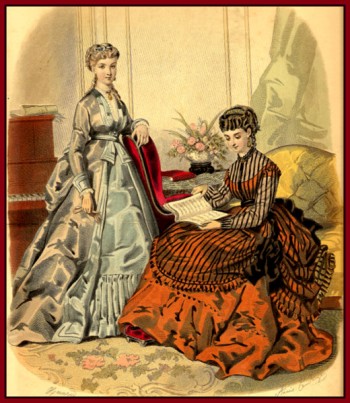
1869
This print is from La Mode Illustree in 1869. These two magnificent crinolin gowns are by Mm. Breant-Casstel who was very fashionable at the time in the centre of Paris. Captured by the famous Artist Anais Tondouze. The models are choosing a music score to play – it could easily be composed by Saint-Saens!
Recordings: Saint-Saens…
Symphony no 3 ‘The organ’ Conuctor Herbert Von Karajan .Berlin Philharmonic Orchestra.Deutsche Grammophon, ASIN B00000IGJZ
Violin Concerto N0 3 Issac Stern. Conductor Daniel Barenboim ASIN B001BHSVO1
Cello Concerto N0 1 / Piano Concerto No2/ Violin Concerto No 3 YO-YO MA, CECILE LICADE, CHO LIANG LIN ASIN B0000027A5

Leo Delibes 1836-1891
Picture insert here……………………………………….. Tchaikovsky was so impressed by the music of Delibes that he considered his own music to Swan Lake to be ‘poor stuff’ compared to the score of Sylvia. He went further by saying that the following German composers, Brahms and Wagner, were not to be compared! In fact, Delibes was the first to raise the quality of ballet music from the poor quality it had sunk to. He had been a pupil at the Paris Conservatoire of Adolphe Adam, the composer of Giselle, who had found him a job as a repeiteur at the Theatre Lyrique at the tender age of 17. This soon spurred him on to compose operettas which amounted to 15 in as many years.
In his late twenties he was appointed repetiteur,then a chorus-master at the Opera, and started to write ballets. He contributed two acts to La Source ( a ballet by Leo Delibes and Ludwig Minkus 1866) which was such a success that he was asked to compose a complete ballet by himself.
The result was the comedy Coppelia (1870) whose wonderful melody and delicate orchestration made it an instant popular favourite. It has remained to this day one of the most popular and beloved of all romantic ballets. His later ballet Sylvia, composed six years later, has not gained so much popularity but is perhaps even greater in scope and colour. Delibes famous opera , Lakme has only been a favourite in France,though the ‘Bell Song’ is still a favourite with coloratura sopranos. ‘To a class of composition which, until then, had been neglected, he brought an elevation and vigour of style, a fullness of forms and a richness of instrumenation unknown before him’ Jean Poueigh (1876-1958, composer, musicologist, and critic )
 Georges Bizet 1838-1875
Georges Bizet 1838-1875
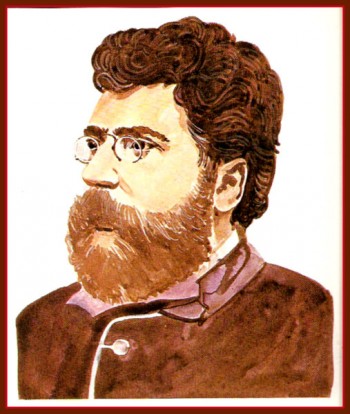
Bizet, whose real name was Alexandre Cesar Leopold showed great musical tastes at a very early age received his first lessons from his father at the age of only four years old. He showed such talent and made such unusually fast progress that he had to obtain exemption from the age-limit to enter the Conservatoire winning the Prix de Rome at the age of 19.
He had written a symphony at 17 . It is a delightful work, full of charming melody and delicate orchestration. It was not played until 1935. At 19 Bizet wrote his first work for the stage,a little operetta,the Miracle Doctor,which won him a prize offered by Offenbach. His first large was Les Pecheurs de Perles in three acts which was performed without particular success in 1863. His next work was The Fair Maid of Perth.It took him six months to write. It shows his ability in creating characters in music and also the ability to link themes together to produce a cohesive story. Bizet’s next important work was a one act operetta, Djamileh.It was not a great success when it was first performed in 1872, although it is considered the only one of Bizet’s early operas which really deserved success. Gounod’s influence was still apparent in Djamileh, but in his next work Bizet broke away from it. The music to L’Arlesienne is the work of a master,as are the piano suite Jeux d’Enfants (1871) and the orchestral version of five pieces from the latter,which Bizet called Petite Suite.No other French composer of the time could express himself with such simplicity and refinement.
In his last composition , Carmen, Bizet made use of everything he had learned and experienced. The French public,however,was not mature enough to accept such powerful music and realistic character portraits,or such an unsentimental view of life. Bizet had suffered from heart attacks from his youth ; but he used merely to stay in bed for a few days and no one thought anything of it. He fell ill three weeks after the first performance of Carmen, on March 3,1875; seemed to be only one more of his customary attacks, though more severe than usual ; he did not recover so quickly and his friends thought he seemed unwell, but in spite of this he took on a large musical work which was to be finished by the autumn. He remained in pain but when it was suggested he delay his move the country for the summer,he said ‘No, no let us get away. The Paris air is poisoning me’ On May 31st the family moved to Bougival ( nine miles from the centre of Paris) The day after Bizet became worse but the local doctor said there was no danger.The next day Bizet had another attack ,the doctor not being called until he could hardly breathe. The doctor did not arrive immediately and when he did arrive Bizet was dead. He died about an hour after the curtain had gone down on the 31st performance of Carmen.
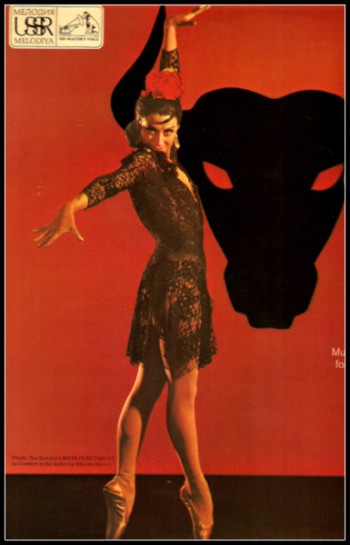
Recording = Carmen
On a better note! – Carmen Recordings later arrived and here are some spectacular images and text regarding The Ballet Carmen with it’s great Ballet Dancers! These L.P. covers have been in my personal collection since they were released.
(Cover photo of Maya Plisetskaya).
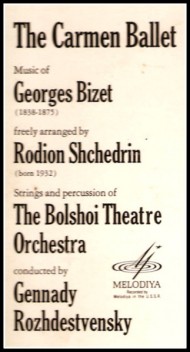
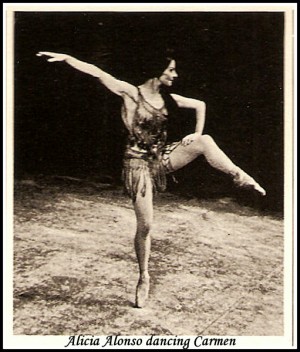
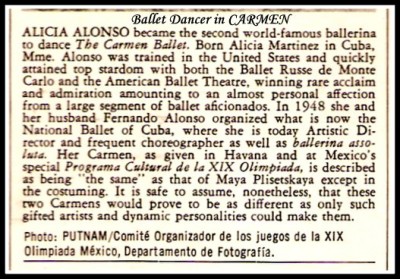
World renowned Ballet Dancer
…………………………………………………………………………………………………………………

Carmen Ballet Recording
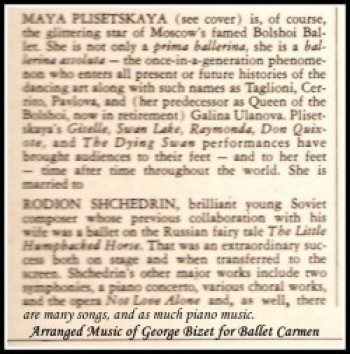
Carmen Text info
Bizet was a cheerful straightforward and good natured man, very sociable and quite unpretentious,but he lacked self-confidence.He took failure badly and once wrote ‘To be a success in our time one has to be either dead or a German’ . Bizet put an end to the old sentimental comic opera and infused new life into opera by making the characters into living, struggling human beings. Though he made no outward changes, he nevertheless created a completely new type of musical drama, both realistic and truly French. His sense of clarity and order and his almost matter-of-fact attitude towards his art were typically French,and in this he resembled Ravel. Romain Rolland ( art historian, novelist,and essayist) said that he is ‘the greatest realization of one extreme of the French musical spirit’
Other Bizet Recordings:
Emmanuel Chabrier 1841-1891
Picture add here………………………………………………………… About text Although Chabrier showed great aptitude for music as a child and became an excellent pianist,his father made hin study for the law and he joined the civil service. It was not until he was nearly forty that he started to devote himself full time to composing. The general opinion was that his music was witty, light entertainment and nothing more,and this attitude persisted far into the 20th century. Nowadays the depth of many of his works is much more appreciated. Chabrier’s masterpeice the opera ‘Le Roi malgre lui ‘ (King in spite of himself ) was performed in in 1887.Rene Dumesil ( musicologist, critic, 1879-1967) said, ‘what music ! What originality,what ability to express something new,what refreshing parody,……His orchestration is as skilful as Wagner’s, only impregnated with light’.
The orchestral rhapsody Espana (1883) shows Chabrier’s most characterteristic qualities. However, his contempories took none of these works seriously,and perhaps he also undervalued them. He then undertook another departure and journeyed to Munich where he heard Tristan and Isolde .He immediately became a passionate Wagnerian ,and his next work,a very serious musical drama, Gwendoline had a very typical Wagnerian libretto . But his true greatness is, and always will be, seen in his lighter works. His lively music is a continuation of Bizet, and his strange emphatic rhythms and charming melodies are typically French.
He never received due recognition in his lifetime,but about 1920 ‘Les Six’ took up his music, and he seemed to be one of those who pointed the road for the future, away from the half-light and mists of impressionism.
‘It is true tat he was more versatile and deeper than is realized,…..I would sooner have Le Roi malgre lui than the Ring of the Nibelung’ (Ravel). Stravinsky was also among Chabrier’s admirers,and he pointed out that ‘ in difficult times Chabrier knew how to maintain the healthy tradition of dramatic art ‘. Other works which are frequently played are Joyeuse Marche (1888) and his piano pieces ‘Pieces pittoresques, of which No6 Idylle and No 10 Scherzo-valse are the most popular.
Jules Massenet 1842-1912
“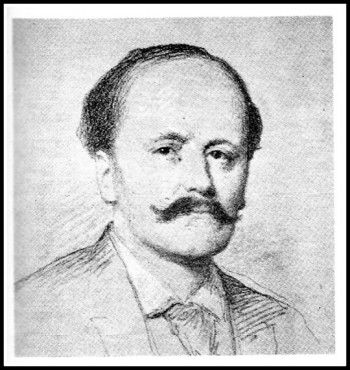 Its’s very odd, when I hear Massenet’s operas I always long for Saint-Saens’. I should add that hearing Saint-Saens’ operas makes me long for Massenet’s”.
Its’s very odd, when I hear Massenet’s operas I always long for Saint-Saens’. I should add that hearing Saint-Saens’ operas makes me long for Massenet’s”.
Henri Guuthier-Villars
Massenet received his first music lessons from his mother and after which he entered the Paris Conservatoire graduating in 1863 at the age of 21 and winning the Prix de Rome. He spent a very fruitful time there soon meeting Liszt. On his return home some of his orchestral pieces were performed.
Several of his orchestral works have remained popular,thanks to there melodic appeal, clear form and brilliant orchesration. His best known is Scenes Pittoresques (1873). However,opera became his greatest interest, composing 21 during his lifetime. Nearly all his opera’s achieved great success in France ,with Manon and Thais becoming world famous. In most of his operas the woman is placed at the centre of story, and he his best when depicting a love story where the music, which is very melodic and perhaps sentimental , comes to the fore. Massenet’s sweet tuneful music set a style in French music which lasted well beyond his lifetime through his influence as professor of composition at the Paris Conservatoire from 1878 until his death in 1912.
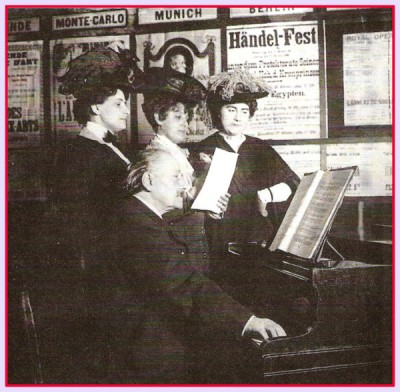
Piano with Massenet
But it is unjust to let his senuous sweetness blind one to his many good qualities: his clear and pure melodic line, his elegant form,his fine harmony,and his effective orchestration. Alfred Bruneau ( 1857-1934,composer,who brought realism to French opera). thinks that if Massenet had desired he could have written works on a bolder and larger scale. That he did not do so was not from lack of ability or inspiration,but the ‘dangerous paths’-where those who ventured had to penetrate thick thorny scrub- attracted him less than the paths hedged on either side with roses. He knew that on the stage love must always triumph,for which reason he specialised in giving expression to love’.
Recordings:..………….
Gabriel Faure – 1845-1924
 Henri Duparc 1848-1933
Henri Duparc 1848-1933
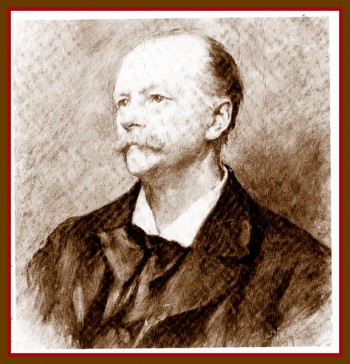
Portrait drawing
Henri Duparc was Cesar Franck’s first pupil but was forced through illness to give up composing at the early age of 37. His illness was mental but he lived a fairly normal family life to the age of 85. He started to go blind in the early 1900’s. He was a cultivated musician and uncomprimising critic of other composers and himself. He admired Wagner and other German Romantics which are apparent in his fourteen exquisite songs which are the basis of his greatest music. If anyone who hears his song Chanson Triste is not moved,then they are never going to be a lover of classical music! His first surviving song cycle dates from 1868.These consist of 5 songs for voice and piano. He expressed doubts about three of them,(Serenade,Romance de Mignon, and the galop), but eventually allowed them to survive. From this early period there exists a sonata for cello and piano (1867) not published but held in manuscript form in his daughter’s estate.
In the early 1870’s he was turning more to the orchestra. In 1874 he wrote Poeme Nocturne but only the first part of three has survived. He composed his symphonic poeme Lenore 1875. Four years later he composed his opera Roussalka. He stoppeds composing in 1885.
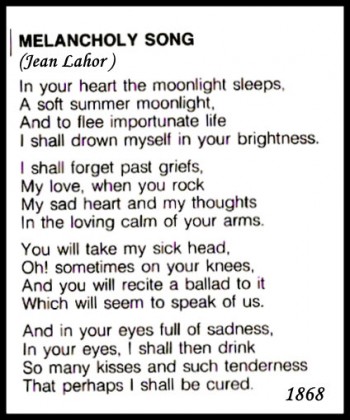
Henri Duparc
These are the Romantic Lyrics for Henri Duparc’s work Chanson Triste..
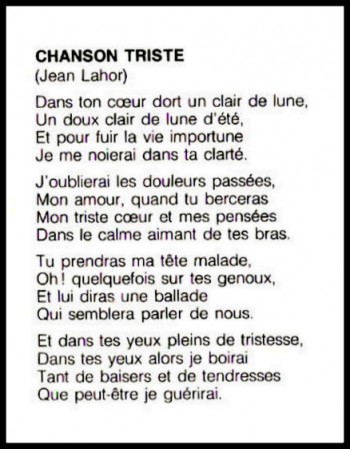
French Translation
…………………………………………………..
 Vincent d’Indy 1851-1931
Vincent d’Indy 1851-1931
Ater extensive musical studies under Cesar Franck and others Vincent d’Indy became a choir conductor in Paris in 1873-1878. He played the kettle drum in the Colonne Orchestra and was also an organist at one of the churchs. His debut as a composer took place in 1875 with the overture,Piccolomini.This was followed by the opera Fervaal.
From 1887 he was choir conductor of the Lamoureux concerts and did much promotion for Wagner’s works. D’Indy was already well known as a composer that when Cesar Franck died in 1890 he succeded him as President of the Societe de Musique. Together with two colleagues he setup the Schola Cantorum where he taught and refined the principales of the Franck School,but also based his teaching to a large extent on the Gregorian chant
D’Indy published a text book on compostion and was vert active in other ways as a writer on music. Although he was a prominent figure in modern French music very few of his works have been produced outside France.
Ernest Chausson 1855-1899
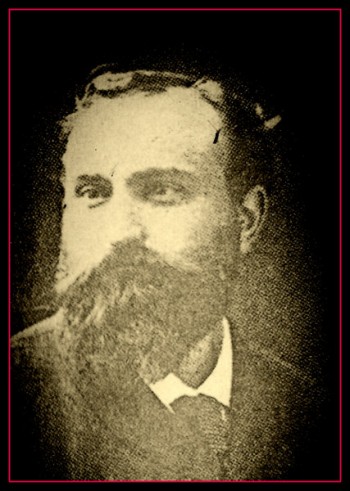 About The effectiveness of Chausson’s ardent even erotic musical language derives largely from the slithery chromatic style the composer inherited from his most important teacher,Cesar Franck. Not a prolific composer,Chausson died in 1899 at the age of 44 from injuries sustained in a bicycle accident. Chausson’s early death silenced the most distinctive voice in French music in the generation preceding Debussy, indeed Chausson’s forms an elegant, if swaying bridge between Franck’s lush Wagnerian romanticism and the sensuous Impressionist language of Debussy. Chausson came from a rich family: in fact comfortable circumstances throughout his life made it unnecessary for him to pursue a life as a musician.
About The effectiveness of Chausson’s ardent even erotic musical language derives largely from the slithery chromatic style the composer inherited from his most important teacher,Cesar Franck. Not a prolific composer,Chausson died in 1899 at the age of 44 from injuries sustained in a bicycle accident. Chausson’s early death silenced the most distinctive voice in French music in the generation preceding Debussy, indeed Chausson’s forms an elegant, if swaying bridge between Franck’s lush Wagnerian romanticism and the sensuous Impressionist language of Debussy. Chausson came from a rich family: in fact comfortable circumstances throughout his life made it unnecessary for him to pursue a life as a musician.
Although interested in music from a young age, he studied to become a lawyer at his father’s behest. In 1877 he was sworn in as a lawyer.In that year he wrote his first work an unpublished song Lilas. The impulse to devote himself to composition came from a visit to Munich to see Wagner’s opera Tristan & Isolde and met Wagner’s disciple Vincent d’Indy.
 Gustave Charpentier 1860-1956
Gustave Charpentier 1860-1956
Picture here …………………………………………… Charpentier was not from a musical family but was encouraged to pursue his interest in music. His formal studies did not begin until he was a teenager. He began working in a spinning mill where his employer,to whom he had been giving violin lessons,sponsored him to begin studying at Lille University. In 1881 he finally entered the Paris Conservatoire.He studied composition with Massenet. He began studying with Massenet in 1885, and only two years later won the Prix De Rome for his cantata Didon.
While living in Rome he composed a symphony subtitled La vie de la poete and also started to compose his opera Louise which became his most popular and most famous composition.
Claude Debussy 1862-1918
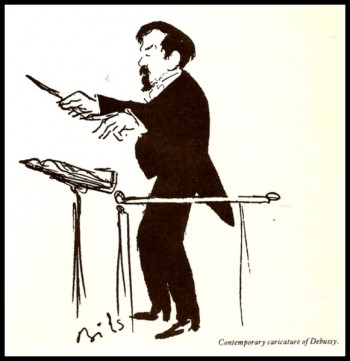
One of the most influential composers to bridge the 19th & 20th centuries. His mature compositions combining modernism and sensuality so successfully that their sheer beauty often obscures their technical innovation. He was considered the founder and leading exponent of impressionism and his adoption of non traditional scales and tonal structures were followed by many leading composers in the 20th century.
The son of a shopkeeper and seamstress he began studies at the Paris Conservatoire at the age of 11. While a student there he met the wealthy Nadezhda Von Meck (the patron of Tchaikovsky) who employed him as a music teacher to her children.Through travel,concerts and friends she provided him with a wealth of musical experiences.She introduced him to other composers most notably Mussorgsky and Borodin. He began composition studies in 1880 and in 1884 won the prestigious Prix de Rome with his cantata L’enfant prodigue. This prize financed two more years study but did not help his creatativity. However the following years proved very fertile with trips to Bayreuth and Paris World Exhibition of 1889.

C. Debussy - portrait L'Illusree
( A very rare portrait drawing of Debussy found recently August 2012).
He wrote his first early masterpiece ‘Prelude a l’apres-midi d’un faun’ in 1894. The next great work was the three Nocturnes of 1899, Nuages, Fetes and Sirenes. His only opera the great Pelleas et Melisande was premiered in 1902. This was a huge success after 10 years of work and influenced younger composers including Maurice Ravel. These works brought a great fluidity of colour and rhythm to western music. La Mer composed 1903-1905, works themes from the first movement in the finale. It is, without any doubt, his orchestral masterpiece. These works and others to follow in the first decade of the 20th century marked him as one the most outstanding French composers. Debussy spent his remaining healthy years composing acting as a critic and performing his own works internationally. He died of stomach cancer in 1918,having spent the war years in a deep depression. He even experienced shelling and bombing from the Germans who were only 80 miles from Paris when the war ended.
Recordings:-
Alberic Magnard 1865-1914
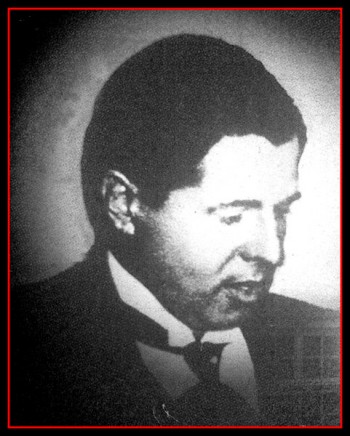
Alberic Magnard lost his mother at the age of four,which marked his character for the rest of his life.His father was wealthy and exerted a strong influence on his son. Alberic was academically clever,having studied law . He completed his military service and then entered the Paris Conservatoire studying under Jules Massenet. He renounced all other comfortable options,determined to make his own way as a composer. He met and befriended another French composer Guy Ropartz. Ropartz had all so lost his mother at a very young age. Through Ropartz he met Cesar Franck and then Vincent d’Indy with whom he studied from 1888 to 1892. His father died in 1894 which devastated Alberic who experienced conflicting emotions of resentment,guilt,regret,gratitude and isolation.The result of this was the orchestral Chant Funebre (1895-1896).
During the last decade of the nineteenth century he produced some of his greatest pieces, including the first three symphonies and the opera Guercoeur in 1900. He went on to write a magnificent final symphony in 1913. Unfortunately his music is seldom played,which is depriving many people from hearing a great French symphonist , a rare enough phenomenon. I have known his music for over forty years on LP and CD. It has never ceased to give me great satisfaction on every hearing. His death was very tragic.He sent his wife and two daughters away at the beginning of the Ist World War in 1914. He stayed at his home defending it from the advancing German soldiers. He shot two soldiers,but refusing to surrender to other soldiers his house was burnt down,not only killing him but destroying all his manuscripts and many works of art. He was only forty nine.
Paul Dukas 1865-1935
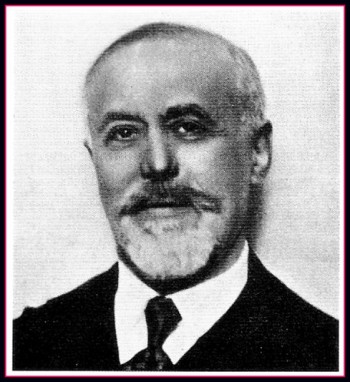 As professor of the orchestral class and of composition at the Paris Conservatoire he exercised great influence as a teacher. He,howver, wrote very few pieces,all of them dating from 1910.He is very famous because of the tone poem,’The Sorcerer’s Apprentice’ (1897). He wrote a powerful symphony and a marvellous ballet ‘Le Peri’ commissioned by Diaghilev in 1912.These all enjoy excellent modern recordings.Quote’ Is it not in music,and in music alone that the secret of music be sought? Paul Dukas.
As professor of the orchestral class and of composition at the Paris Conservatoire he exercised great influence as a teacher. He,howver, wrote very few pieces,all of them dating from 1910.He is very famous because of the tone poem,’The Sorcerer’s Apprentice’ (1897). He wrote a powerful symphony and a marvellous ballet ‘Le Peri’ commissioned by Diaghilev in 1912.These all enjoy excellent modern recordings.Quote’ Is it not in music,and in music alone that the secret of music be sought? Paul Dukas.
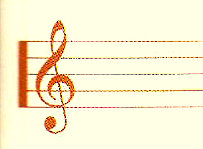 Albert Roussel 1869-1937
Albert Roussel 1869-1937
Albert Roussel was 25 when he abandoned his early naval career to study music. One of his teachers was Vincent d’Indy. He developed a unique style early on,producing a very distinct ‘sound’ which cannot be grouped with any other school of French music. His first great work is his 1st symphony ‘Le Poeme de La Foret’ completed in 1906. Perhaps his most famous piece is ‘Le Festin de L’Araignee’ (The Spider’s Feast) composed in 1912. He wrote a further three symphonies , with the third (1930) and the fourth (1934) being at the apex of his very special ‘sound’.I came to know these wonderful symphonies when there were very few recordings over forty years ago. They still sound fresh as though they were written yesterday. It is a great pity that there is so little exposure of this magnificent music. He wrote a further magnificent ballet score ‘Bacchus et Ariane composed in 1931 just after the third symphony . He reworked the Ballet into two separate concert suites, the second being the most often played. It is an exciting and very invigorating score, with strong melodic harmonies that climax at the end in a blaze of magnificent orchestral sound. It is in every way on a par with Ravel’s ‘Daphnis & Chloe’.
Quote by Henri Prunieres (1886-1942, French musicologist) ‘Roussel is a poet. He siezes the manifold and mysterious echo that nature produces in the human soul and clothes it in the magic of sound. His Forest Poem breathes the perfume of the trees, his Evocations is a mirage in which, under a sky of purple and gold we catch a glimpse of the cities of the Far East. He is sincere.masculine and stern, but never ascetic, on the contrary,he is decidedly sensual, but in a straight forward and healthy way’
 Florent Schmitt 1870-1958
Florent Schmitt 1870-1958
A pupil of Faure and Massenet ,Schmitt produced music of a very independent character. It is very strong and passionate ,but he remains an isolated of the first half of the 20th Century. Perhaps not for French taste his music is composed on a vast scale, highly romantic and even anticipating some of the savagery of Stravinsky’s The Rite of Spring.
His most famous work is The Psalm XLVII, written in 1905 and first performed in 1910. It is a vast work for chorus and orchestra ,commencing extremely loud and powerful, but at its heart has a most beautiful soprano soloist singing music of sweetness and subtle melody. It is also worth mentioning ‘La Tragedie de Salome’ a ballet first performed in 1909 and subsequently fully orchestrated and performed in 1911. It was based on the famous story of Salome and St John the Baptist. Stavinsky onc wrote the following words ‘ I must admit that this is the greatest joy a work of art has given me for a long time!’
Maurice Ravel 1875-1937
Perhaps one of the greatest of all French composers,he entered the Paris Conservatoire in 1899 coming under the influence of Chabrier and Satie ,however by his early 20’s he cultivated a highly individual and original style recognizable in early compositions such as Menuet Antique and Sites Auriculaires( both 1895). His most beautiful well known early work is the ‘Pavane pour une Infante defunte’ composed as a piano piece in 1899 and later fully orchestrated in 1912. The wonderful ‘Rhapsodie Espagnole’ was composed in 1907. The Mother Goose Suite (Ma Mere L’Oye) was orchestrated in 1908 , having originally been composed for two pianos. In 1912 the magnificent ballet ‘Daphne & Chloe ‘ commissioned by Diaghilev , was first performed. Here we have one of the great ballet scores which Ravel reworked into two symphonic suites which are quite often played as part of an orchestral concert. The music is so beautiful and exciting that it can well stand by itself without one ever seeing the ballet. His most performed opera is ‘L’Enfant et Les Sortileges’ from a text by Colette (1920-25) is all about a child discoursing with inanimate objects and nature. The child’s reactions (negative and positive) provide a pretext for a series of bizarre and fairy-like episodes. This makes the opera a unique experience.
Coming now to his two great piano concertos of 1931, the 1st in G minor is a homage to Mozart seen through the eyes of Saint-Saens. The slow movement has a supreme calmness and purity that reminds me of his great teacher Faure. The Concerto for the Left Hand (written for Paul Wittenstein,who lost his right arm in the 1st world war) ,is a much more aggressive piece in one movement leaves one quite breathless and excited by its inevitable progression.These two works were the last works that Ravel composed as his health increasingly declined in the 30’s , as he had suffered from shell shock contracted from his 1st World War service. Quote (Nearing his death)’ I still have so much music in my head.I have said nothing.I have so much more to say’. Quote 2. ‘ I think and feel in sounds. (1907).
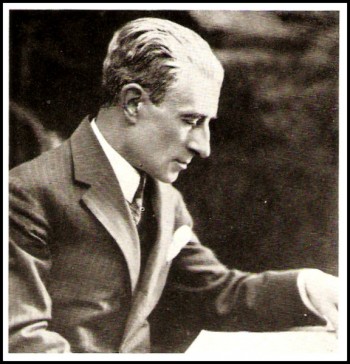
 Arthur Honegger – 1892-1955
Arthur Honegger – 1892-1955
picture add here………………… Born in Le Havre of Swiss-German parents .He was educated in his early years in Le Havre, then in his early teens he went to Zurich to study for four years and then at the age of nineteen at the Paris Conservatoire where he came into contact with Milhaud ( a lifelong friend) and the other Les Six. His dramatic oratorio ‘Le Roi David’ of 1921 brought him great fame. At this time he composed the beautiful ‘Summer Pastorale’ (1920). In 1923 he composed one of his most famous pieces ‘Pacific 231’ depicting the power of particular locomotive. It is a striking work, full of strength and and excitement. Honegger had a lifetime passion for trains. Honegger had a inclination to compose serious music which can be found in his five symphonies and particularly his biblical opera Judith, composed in 1925. I end this information with an interesting selection of quotes.
‘ I attach great importance to musical architecture , which I should never want to see sacrificed for reasons of a literary or pictorial order. My model is Bach …… I do not seek, as do certain anti-impressionists, the return to harmonic simplicity. I find,on the contrary, that we should use the harmonic materials created by the school that preceded us,but in a different way, as the base of lines and rhythms. (Arthur Honegger)
I am like a steam engine: I need to be stoked up,it takes me a long time to get ready for genuine work.
My inclination and my effort have always been to write music which would be comprehensible to the great mass of listeners and at the same time sufficiently free of banality to interest genuine music lovers. (Arthur Honegger)
From his first works up to ‘Joan of Arc at the stake’ and the Liturgical Symphony (3rd) ,Honegger has constantly reached greater heights and constantly renewed himself.His work not only stands in the forefront of today’s music—-but it seems that it will record all that our time has to offer. (Rene Dumesnil) ( literary critic,musicologist.)
 Francis Poulenc 1899-1963
Francis Poulenc 1899-1963
 A unique and very special composer, little known outside France, he had two strong opposing personalities. The first a very approachable person writing smart salon pieces in a popular style, and the other a devout Christian producing serious religious works,concertos and operas. He has a very distinct melodic style,instantly recognizable with a strong abrasive bent which came to fruition in his great Organ Concerto of 1938.
A unique and very special composer, little known outside France, he had two strong opposing personalities. The first a very approachable person writing smart salon pieces in a popular style, and the other a devout Christian producing serious religious works,concertos and operas. He has a very distinct melodic style,instantly recognizable with a strong abrasive bent which came to fruition in his great Organ Concerto of 1938.
He is quoted as saying that the following people shaped his personality: ‘Ricardo Vines,the great Spanish pianist whose pupil I was,Serge Diaghilev,through whom I made the acquaintance of Stravinsky and Guillume Apollinaire and Paul Eluard, the two poets who have fertilised my vocal and choral works.’
He wrote a very successful ballet ‘Les Biches’ (the House Party) for Diaghilev in 1924. He wrote a beautiful piano concerto in 1950 and a magnificent opera ; The Dialogue des Carmelites’ in 1957.
All his life his works were a constant mixture of the religious and secular.
Quotes: ‘My music is my portrait’
On the radio a lady has just been caterwauling for a quarter of an hour some songs which may well have been mine!
 Georges Auric 1899-1983
Georges Auric 1899-1983
A member of ‘Les Six’ Auric made his mark in incidental and dramatic music for ballets and for long periods in films. He wrote for Diaghilev , the earliest being ‘ Les Facheux ‘ (1924) and Les Matelots (1925). The main ballet music was written between 1924 to 1934 and 1949-1952. He wrote his film music mainly between these two dates. The films included ‘Les Parents Terribles’ and ‘Orphee’ and the more famous ‘Moulin Rouge’ of 1952 about the great artist Toulouse-Lautrec.
Auric was born in 1899.He began his studies at the Montpellier Conservatory and then the Paris Conservatory and Schola Cantorum where he studied with Vincent d’Indy and Albert Roussel. By the time he was sixteen he had composed Gaspard et Zoe,( piano) as well as some 300 songs and other piano pieces. As part of the disillusioned young generation that had survived the 1st World War , he joined the anti-romantic movement that had formed around Satie and Cocteau. Ideally it was the new. the innovative concept of music as something that should produce auditory pleasure without demanding disproportionate attention from the listener. Auric found himself enjoying the company of ‘Les Six’ ( Poulenc,Milhaud,Honegger,Durey & Tailleferre).He composed music full of irony, popular tunes combined with advanced harmony. He never gained the popularity of Milhaud,Poulenc and Honegger. However a critic Boris de Schloezer,(a Russian writer who left Russia in 1917 and stayed in France for the rest of his life), remarked in 1926 that Auric’s conscious ,self-ironic efforts to create the appearance of superficiality may conceal a profound musical depth.
In 1930 he composed a Sonata for Piano in F, a serious lyrical work which may seem at odds with the composer’s public image.
In later years he assumed a number of administrative responsibilities . From 1962 to 1968 he was the general administrator of the Opera and Opera Comique in Paris. This was right in the middle of his tenure from 1954-1977 as President of the French Union of Composers and Authors. He wrote musical criticism for Paris-Soir and Nouvelles Litteraires. He died in 1983.
 Olivier Messiaen 1908-1992
Olivier Messiaen 1908-1992
When the 20th century is long gone (perhaps now!) it may be that Mahler and Messiaen will be seen as the colossi of that century,in the same way that Beethoven and Wagner stand out in the 19th . Often misunderstood ,Messiaen’s music occupies a different plane from every other major 20th century composer. Its purpose is to express the glory of creation ,and through the creation the glory of God: its theme is the cosmos, and the mysteries of the cosmos, life and death, creation and destruction, and the wonder of nature. For Messiaen the foundation for that expression was the Catholic church , not the church of social rules and behaviour , but that of the Christian mystic.
Messiaen is one of the most spiritual composers of any age. Many of his works are vast in duration and scale . His music often operates in different time scales than those normally associated with music. Messiaen was one of the major technical innovators of the of the 20th century , in part to find the means of expression for this meditation on the cosmos. Messiaen was the chief figure in turning French music radically away from the neo-classicism and tradition of charm and flippancy that had dominated between the World Wars. The first innovation was harmonic, in what he termed ‘modes of limited transposition’. The Mode referred to is a scale of notes, in which the intervals between the notes are so designed that there are only a limited number of times that the scale can be transposed, maintaining those intervals before the pitches of notes are repeated. The sound that such harmonic devices created have become a normal currency of subsequent 2oth century composition for composers of a wide range of styles and procedures,even though they are rarely arrived at with the systematic technical means used by Messiaen. The second innovation was rhythmic. Messiaen introduced the widespread use of rhythmic patterns based on Eastern musical traditions, particulary those of Indian classical music ,where rhythmic events unfold on two simultaneous time-scales ,that of a pattern or phrase of beats which is itself repeated in a larger pattern, and those of Balinese gamelan music.with its regular repetitive patterns of irregular rhythms.
A major characteristic of Messiaen’s music, one so thoroughly explored that it has become virtually impossible for any other composer to emulate it, was the the influence and inspiration of bird-song.It fascinated Messiaen from an early age, and provides the basis for many of his melodic ideas throughout his career,especially in the early 1950’s. On a philosophical level, bird-song represents the aspect of the natural in the cosmos, the musical representation of nature around us.
All the technical devices,fascinating and influential though they are, are strictly means to and end,and knowledge of Messiaen’s technique is not necessary to feel the impact of his music. Indeed, there is a completely different way of considering Messiaen’s idiom. Messiaen himself said that all his music was influenced by the landscape of the French Alps, and there is a sense that his music is an evocation and this of the vastness of the cosmos that many experience when visiting mountains.
His output can be divided into fairly distinct periods,though there is a strong continuity of voice throughout. In his works to 1935 Messiaen forged his idiom, and this period shows lingering traces of his early influences. from 1935 to 1950 he developed the spiritual and religious content , the rhythmic aspects of his music , and the use of large scale cycles. This period includes a trilogy of works- the song cycle Harawi, Cinq rechants for chorus, and the Turangalia- Symphonie.(see my Blog on this extraordinary work). There were other periods which culminated in his final great period from 1970 to his death. The works included Des Canyon aux etoiles for piano horn and orchestra, the opera St Francois d’Assise,and the two organ cycles,Meditations sur le mystere de la Sainte-Trinite and Livre du Saint Sacrement in which he utilized all his experiences in a language often more luminous and simplified. Combined with this is a spiritual understanding that is both rarified and more profound in its unity. Messiaen became organist of L’Eglise de la Trinite in 1930 and remained there for over forty years. At this time he had already written the set set of eight preludes (1928-1929) for piano. These lovely,sometimes mysterious pieces owe something to the piano music of Debussy but also show unmistakable Messiaen mannerisms. Bird-song is not used directly, but there is a definite suggestion of it in the trills and answering calls ,and much of the impact of the pieces is achieved through an emphasis on changing colours and sonorities. Hints of exoticism are in part created by the ‘ modes of limited transposition’ which Messiaen here specifically associated with actual colours ,building the juxtapositions of the pieces accordingly. The ‘Preludes’ make a suitable introduction for those new to Messiaen’s music. The importance of Messiaen as a teacher ,and the very high calibre of his students,has already been indicated. He taught at the Ecole Normale de Musique and at the Schola Cantorum in Paris, and widely outside Europe in the late 1940’s. He was appointed professor of harmony at the Paris Conservatoire on his release from a prisoner of war camp in 1941,and a class for analysis was specially created for him there.
–oOo–


Music - Articles by Trevor Doyne-Ditmas 2012


